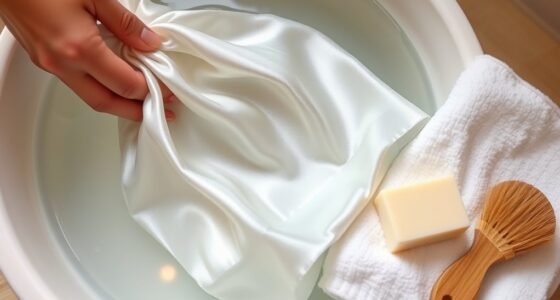If you’re deciding between air drying and machine drying, consider your clothes’ fabric, time, and environmental concerns. Air drying is gentle, saving energy and helping your clothes last longer, especially delicate fabrics. Machine drying is quick and convenient, perfect for busy schedules but uses more electricity and can wear out clothing faster. To learn which method suits your needs best, explore the detailed differences and tips below.
Key Takeaways
- Air drying is eco-friendly and reduces energy costs, while machine drying consumes more energy but offers quick results.
- Delicate fabrics benefit from air drying to prevent heat damage, whereas machine drying can be suitable with gentle settings.
- Air drying is gentler and extends clothing lifespan; machine drying is faster but may cause wear over time.
- Weather and space influence air drying feasibility; machine drying provides convenience regardless of environmental conditions.
- Choose based on priorities: sustainability and fabric care favor air drying; speed and convenience favor machine drying.

When it comes to drying your clothes, you have two main options: air drying or machine drying. Each method has its own advantages and considerations, especially when it comes to energy efficiency and fabric care. Choosing the right method depends on your priorities, lifestyle, and the types of clothes you wear. If you’re looking to save energy and preserve the longevity of your fabrics, understanding the nuances of both options can help you make smarter choices.
Air drying is often seen as the most energy-efficient method. It doesn’t require electricity or gas, which means you avoid increasing your utility bills and reducing your carbon footprint. Plus, it’s gentle on fabrics. When you hang clothes to dry naturally, you minimize the risk of heat damage, shrinkage, or wear caused by high-temperature tumbling. This method is especially ideal for delicate fabrics like wool, silk, or lace, which can lose their shape or texture when exposed to high heat. furthermore, air drying allows your clothes to retain their original softness and color vibrancy longer, helping you extend their lifespan. However, it does depend on good weather conditions, adequate space, and patience, since air drying can take several hours or even a day, especially in humid environments.
Air drying is eco-friendly, gentle on fabrics, and preserves your clothes longer, but requires good weather and patience.
Machine drying, on the other hand, offers unmatched convenience and speed. With a tumble dryer, you can dry a load of laundry in a fraction of the time, making it perfect for busy schedules or when you need clothes quickly. Modern machines often come with energy-efficient settings designed to reduce power consumption, but they typically still consume more energy than air drying. When it comes to fabric care, machine drying can be tough on clothes. The tumbling action combined with heat can cause wear and tear over time, especially for delicate or specialty fabrics. High heat can also cause shrinkage, fading, or stiffness, which might shorten the lifespan of your garments. To mitigate these issues, you can opt for lower heat settings or use dryer balls to reduce static and fluff, but it’s still a more aggressive process compared to air drying. Additionally, some fabrics can benefit from specific drying techniques, such as proper drying methods, to prevent damage.
In the end, the decision between air drying and machine drying hinges on what you value most. If saving energy and caring for your fabrics are your top priorities, air drying is the better choice. It’s eco-friendly, gentle, and cost-effective, though it requires more time and space. If convenience and speed are more important, and you’re willing to accept some wear on your clothes, then machine drying offers a practical solution. Understanding these differences enables you to make informed choices that align with your lifestyle, budget, and fabric care needs.
Frequently Asked Questions
How Does Drying Method Affect Clothing Lifespan?
Drying method impacts your clothes’ lifespan considerably. When you air dry, you reduce fabric pilling and odor retention, helping garments stay fresh longer. Machine drying, especially high heat, can cause fibers to weaken and develop pilling faster, shortening their life. Plus, heat may trap odors. So, if you want your clothes to last, opt for air drying whenever possible, as it’s gentler on fabrics and maintains their quality longer.
Can Air Drying Prevent Color Fading Better Than Machine Drying?
Did you know that air drying can reduce dye fading by up to 50% compared to machine drying? When you air dry clothes, you minimize heat exposure, which helps preserve color and prevent dye fading. This gentle method keeps your colors vibrant longer. So, if color preservation is your goal, air drying is your best option. It’s a simple way to extend the life of your clothes’ hues and keep them looking fresh.
Is Air Drying More Energy-Efficient Than Machine Drying?
Air drying is more energy-efficient than machine drying because it uses less energy, reducing your overall energy consumption. By avoiding the use of a dryer, you lower your environmental impact, helping to conserve resources and decrease greenhouse gas emissions. Plus, air drying can save you money on electricity bills. So, if you’re looking to be eco-friendly and cut down on energy use, air drying is a better choice.
Which Method Is Better for Delicate Fabrics?
You should air dry delicate fabrics because it’s gentler, helping maintain their fabric softness and preventing damage. Air drying reduces wrinkles naturally, saving you time on ironing. Machine drying might cause shrinkage or weaken fibers, especially with delicate materials. By choosing air drying, you preserve the quality of your fabrics, keeping them soft and wrinkle-free longer. It’s the best method for delicate clothes that need extra care.
How Do Drying Methods Impact Fabric Shrinkage?
Did you know that improper drying can shrink clothes by up to 5%? When you machine dry, high heat can cause fibers to contract, leading to shrinkage. Air drying reduces this risk, helping fabrics retain their original size. Plus, it preserves fabric softening and moisture retention, making your clothes softer and more comfortable. So, if you want to avoid shrinkage, air drying is your best bet.
Conclusion
So, whether you choose air drying to save the planet—or just to avoid shrinking your favorite sweater—remember, your laundry choices are your silent rebellion. Sure, machine drying offers speed and convenience, but at what cost—your energy bill or your dignity? In the end, it’s all about balance. Or maybe just about convincing yourself that hanging clothes outside is somehow more virtuous than pressing a button. Either way, your laundry routine says a lot about your priorities—so choose wisely.









